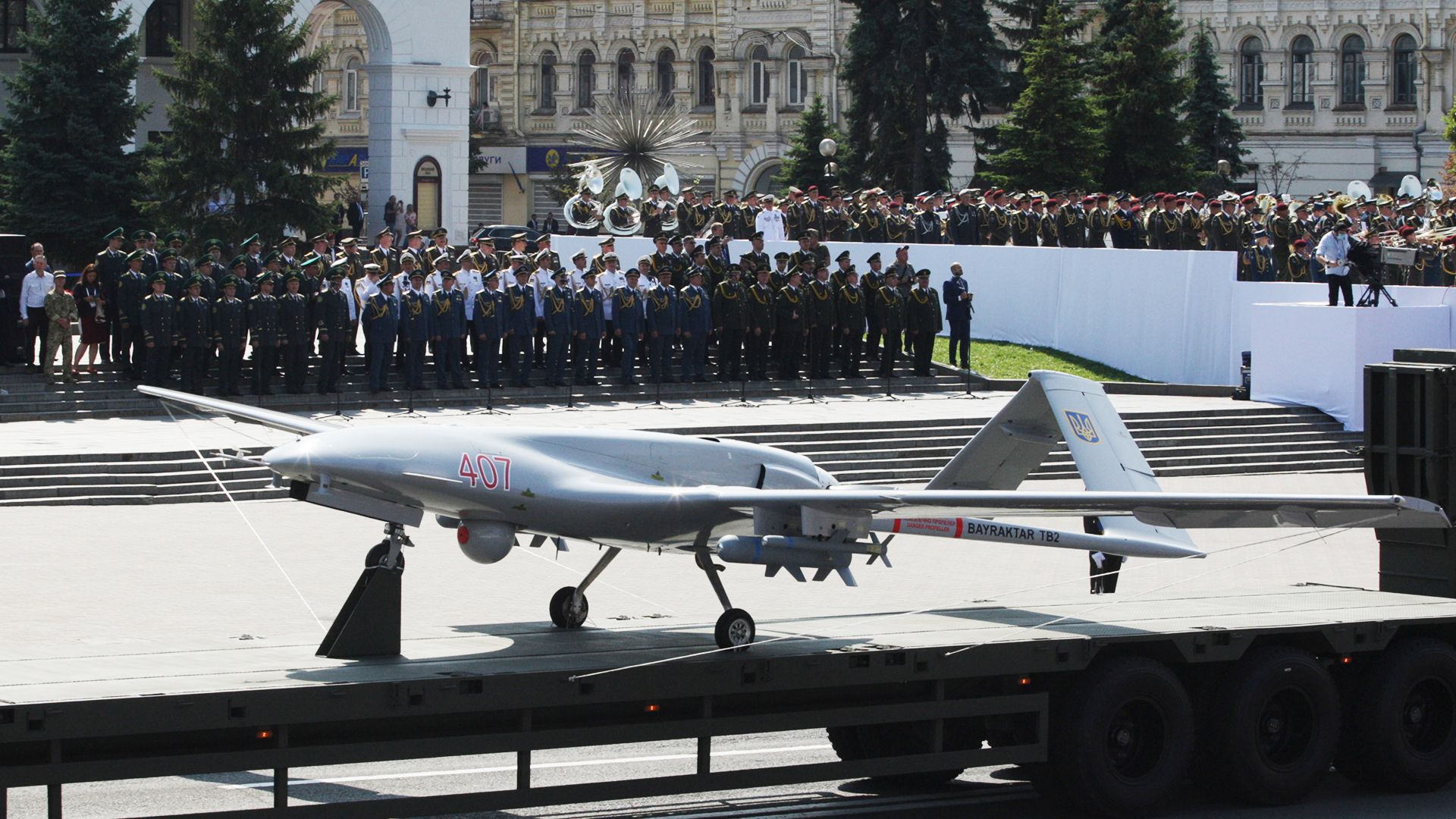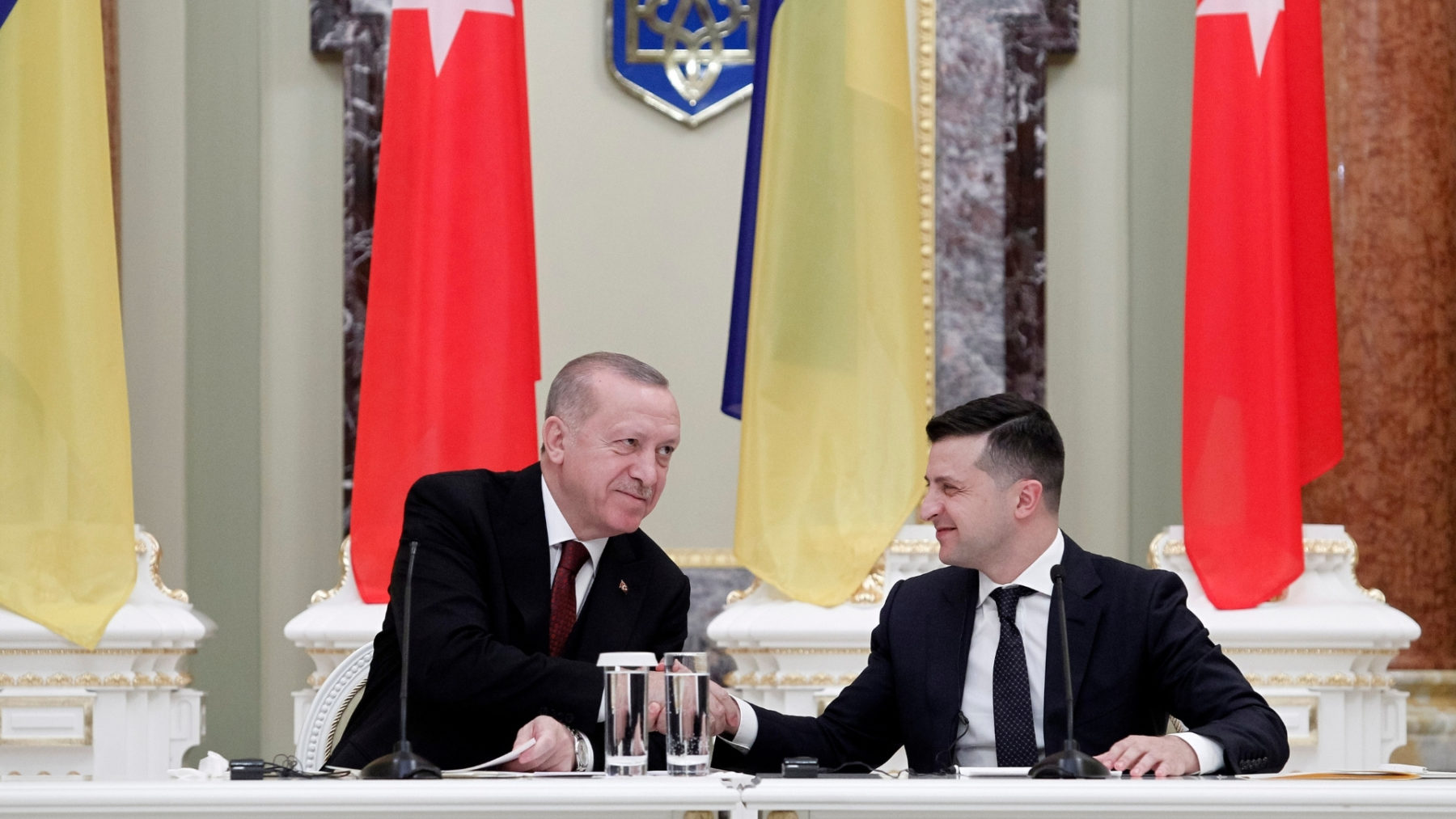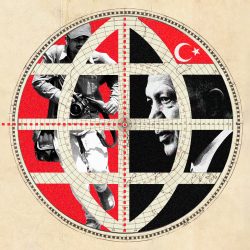
Vladimir Shtanko/Anadolu Agency via Getty Images
Turkey’s drones had a bad reputation. The war in Ukraine has changed that
In late February, a column of mobile Russian Buk surface-to-air missiles snake along a road near Malin, northwest of Kyiv, framed by looping tire-tracks in the surrounding earth. The black-and-white drone footage is slightly grainy, but the target is clear. The drone’s camera shifts position slightly, rotating as its Ukrainian operators on the ground discuss the target. It hones in on a lone Buk in the center of the pack, like a predator picking off an unsuspecting gazelle from on high.
“He’s running away from this Buk I think — or maybe to that side?” asks one drone operator, watching a black speck — a Russian soldier — on the screen. “Maybe something fell off and he went to check what it was. He’s just running back and forth,” says another, as the speck changes direction.
“Position” flashes at the top of the screen, before the Buk explodes into a voluminous cloud of black smoke. Applause and excited cheers break out in the control room. “Finally!” says one operator. “What fireworks,” adds another.
The successful hit was one of a growing number of drone strikes conducted by the Ukrainian military against Russian targets using Turkish Bayraktar TB2 drones. The footage, shared by the Ukrainian defense ministry and immediately spread online, has only come to enhance the idea of the drones stealthy power, sneakily bringing destruction to lines of Russian tanks or ammunition from afar and then displaying the grainy evidence for all to see. The Ukrainian embassy in Turkey tweeted footage of a Bayraktar TB2 exploding a column of Russian artillery in a white sparkling cloud alongside a phrase that roughly translated means “thank God for Bayraktar.”
This kind of publicity is a boon for Turkey, which has long held ambitions as a global drone superpower, eagerly demonstrating their use of this homegrown technology across the world, from Nagorno-Karabakh to Libya and northern Syria. But through drone sales, Turkey is also developing an international reputation as a country that will step in with easily available, cheaper and reliable drone technology where other nations like the United States enforce export controls, or at the very least ask questions about how their technology is used.
Ukraine has transformed if not rehabilitated the image of Bayraktar TB2s, with the drones now seen as an essential tool in the fight for democracy on the edge of Europe rather than a flying predator employed in asymmetrical warfare or by governments willing to use them to attack civilians.
Part of this transformation rests on the drones’ ability to record strikes, making them an essential eye in the sky for Ukraine’s information war as much as their aid to action on the ground. Though Ukrainian forces are clearly maximizing the drones’ effectiveness, taking out columns of Russian artillery or even using cheaper commercial drones to help them aim at enemy lines, Ukrainian authorities have so far declined to release clear data on how many times they have successfully employed Bayraktar TB2s or precisely where the strikes took place, including when asked for this story.
Ukraine’s drone arsenal numbers at most fifty. Yet the drones are the only piece of military hardware that comes with an inbuilt camera, setting them apart from the Javelins and MANPADS also used to fend off the Russian advance, and allowing Ukraine to display footage of the strikes to boost morale and galvanize international support for their fight.

Turkish military analyst Arda Mevlutoglu compared the drones’ fight against larger Russian equipment to a David versus Goliath battle. “This might be the reason why the Ukrainian military gives them so much emphasis in their public relations campaign,” he said. “Footage showing destroyed equipment, particularly sophisticated equipment or slain enemy troops multiply the psychological effect. Even if not much equipment is destroyed, the dissemination of such imagery through social media creates a snowball effect, which is very useful for propaganda warfare.”
Aided in no small way by Clash Report, a Twitter account with 169,000 followers believed to have links to the Turkish military due to its unique access to battle footage, suddenly the name Bayraktar has become a rallying cry for Ukrainian freedom. The Kyiv zoo named a baby lemur Bayraktar, days before Ukrainian police forces named a German Shepherd puppy “Special Bayraktar,” for his ability to bark and warn others of incoming explosions. The Ukrainian Land Forces composed an ode to the drones, featuring spoken word praise over a kaleidoscope of jingly electronic xylophone sounds.
Clash Report took what was previously a low quality video accompanying the song, showing a Bayraktar TB2 drone cruising over a blue sky, and tweeted a replacement showing footage of drone strikes timed to the beat, an instant viral hit.
Sinan Ulgen, director of the Istanbul think tank the Center for Economics and Security Policy, labeled the drones a “matter of national prestige,” for Turkey, one so domestically popular that it transcends contentious local politics. The drone program, he explained, has helped Turkey propagate an international image as a technologically astute and ambitious power that has successfully manufactured a cheap but highly effective piece of technology. “There, Turkey can compete in the big leagues,” he said.
Bayraktar TB2s are estimated to cost $1 million to $2 million each, up to a tenth of the price of a U.S.-produced Reaper drone. “There are more able drones in the world, these are not the most capable. There are also cheaper ones,” Ulgen said. But with its drone program, “Turkey has found and developed a soft spot in terms of combining price and capability.”
This makes Turkish drones cheaper than American or Israeli drones, but more capable than Chinese drones, according to Ulgen. “It’s also one of the armed drones that now boasts considerable warfare experience, it has a proven track record,” he said.

Turkey, a NATO member with ties to both Russia and Ukraine, has been trying to navigate how to promote the drones’ success without angering Russia, even after Turkey’s president, Recep Tayyip Erdogan, visited Kyiv in early February and expanded an agreement to manufacture Bayraktar drones in Ukraine. Turkey imports almost a third of its natural gas from Russia, depends on Moscow for foreign currency inflows, and even provoked U.S. sanctions in 2017 by purchasing Russia’s S400 missile defense system. The threat of any kind of backlash from Moscow looms over the Turkish government, which is trying to manage the fallout from an ongoing economic crisis that has seen the lira lose half its value in just one year. Foreign minister Mevlut Cavusoglu put it bluntly in a recent interview with Turkish television: “We can’t afford to take sides,” he said.
Footage of Bayraktar TB2s blowing up columns of Russian targets seems unlikely to smooth the Kremlin’s grievances with Turkey and risk damaging Turkey’s position as a negotiator between the two sides. Deputy Foreign Minister Selim Kiran felt the need to emphasize recently that Turkey’s drone sales to Ukraine remain, in his words, private sales not “aid from Turkey.”

In 2005, on a bleak airstrip surrounded by cornfields, a young engineer and MIT graduate named Selcuk Bayraktar attempted to convince an assembled group of observers that Turkey could become a great drone power. After providing them with a demonstration of his small Unmanned Aerial Vehicles, or UAV’s, bumpily taking off and landing on the small runway, he gave a passionate speech arguing that Turkey had the capability to lead the world in drone production if they invested in his vision.
It could all be so simple, he explained, extending his hand in the air as if to show a smooth path to the future. “Turkey can be number one in the world in five years,” he declared.
Bayraktar has become something of an Elon Musk figure in Turkey, with a fanbase obsessively following his creations and who view him a technological savant. His work is tightly bound up with his country’s ambitions as a global power, particularly a desire to show that it can stand on its own and produce vital technology without depending on weapons imports, particularly from the United States. Bayraktar’s prediction about the growing power of drones also turned out to be correct, aided by Turkey’s decision to sell his drones to any country willing to purchase them and his 2016 marriage to President Erdogan’s youngest daughter.
“The marriage possibly gave them an edge in the end phase, in terms of becoming a client of the Turkish government, but also having the strong international backing of the government,” said Ulgen, the analyst.

Bayraktar’s success has not always been well received internationally, including at his alma mater. Physicist Max Tegmark provoked outrage in Turkey earlier this year when he said of Bayraktar: “I’m ashamed we trained him here at MIT.” Baykar, the company which manufactures Bayraktar TB2s and where Bayraktar is chief technology officer, did not respond to multiple requests for comment for this story.
Bayraktar’s ambitions have long proved in sync with those of his father-in-law, who has frequently declared that his aim is to see Turkey manufacture its own technology and eschew any reliance on partners like the United States. “Our goal is a fully independent Turkey in the defense industry,” Erdogan declared earlier this year at the launch of a new ship operated by the country’s intelligence services.
Turkey began by using Bayraktar’s drones for strikes targeting Kurdish militants in northern Iraq and later Syria, where observer organizations such as Airwars found that strikes have also claimed civilian lives. Turkey states that in northern Syria alone, the drones clocked in 1,129 strikes over four months in 2018. The strikes quickly formed part of what some analysts labeled Turkish “techno nationalism,” fuelled by heavily edited YouTube videos of the drones taking off from airstrips in southern Turkey, followed by drone footage filmed over the mountainous region of northern Iraq.
Domestically-produced drones, particularly TB2s, have since formed a central pillar of Turkish efforts to reshape warfare and alter the outcome of regional conflicts to see results favorable to Ankara.
In April 2020, opposing forces loyal to the Libyan warlord General Khalifa Haftar accused militia groups in Tripoli of using a Turkish drone to strike a food convoy, killing at least five civilians. In the same year, Tukey’s decision to provide Azerbaijan with Bayraktar TB2s enabled Baku to reclaim territory from Armenia in a war over the disputed area of Nagorno-Karabakh. International organizations opposed Turkey’s drone sales to Azerbaijan which reportedly updated online videos of its drone strikes and broadcast them on screens throughout the capital.
A report by the Armenian National Committee of America examining Bayraktar technology found American, Canadian, British, German, Swiss and French components, including American radio manufacturer Garmin, which responded that the technology was intended for civilian use only and pledged to prevent its further misuse. Last year, Canada withdrew export licenses to Turkey for optical sensors and targeting systems made by a Canadian company, citing the technology had been used inside Bayraktar TB2s deployed in Nagorno-Karabakh without consent.
But these controversies have not dented sales. “What armies want to do is use technology that’s battle tested so they’re not the ones trying to debug along the way,” said Sarah E. Krebs of Cornell University, a political scientist and former U.S. Air Force veteran who has worked with drones.
Qatar and Morocco acquired TB2’s, while Tunisia recently acquired a small drone fleet from TAI, another Turkish drone company, despite a tense relationship with Turkey. Ethiopia, which has bought several kinds of drones including Bayraktar TB2s, is accused of using the drones in attacks that killed dozens of civilians. An investigation by POLITICO found photos of fragments of the MAM-L bomb exclusively carried by Bayraktar TB2s at the site of an attack on a school holding internally displaced people, including children.
While Bayraktar was facing scrutiny about the use of his drones in Nagorno-Karabakh, a burgeoning new Eastern European market was forming. Ukraine reportedly bought six Turkish drones and three ground control stations in 2019, but last year dramatically upped their demand and bought another twenty-four. That year, Poland became the first NATO member to purchase Bayraktar TB2s. As Russian forces began massing on Ukraine’s borders, other countries concerned by Russian advances such as Lithuania and Latvia both publicly mulled purchasing Turkish drones.
By last year, Bayraktar TB2s had acquired an international reputation as a cheap and deadly piece of technology, primed to become a pillar of Ukraine’s successful war narrative. Ukraine even paraded a TB2 through the streets of Kyiv during independence day celebrations last August, and later broadcast footage of a lone drone strike on a Russian howitzer, a large artillery weapon, in Donbas in October — the first salvo in their efforts to use the drones as messaging and not just weaponry.
Russia’s defense ministry began seemingly chasing the success of Ukraine’s drone videos weeks into their invasion, publishing heavily edited black-and-white footage that they claimed showed two of their helicopters launching missile strikes on Ukrainian military equipment. This included brief scenes showing the attack helicopters honing in on their targets, a fun-house mirror version of the videos produced by the Ukrainian side.
Russia, which possesses its own domestically-produced drone army estimated to number around 500, seems to have been caught unawares by Ukraine’s drone fleet. “The Russians have been an amazing mix of arrogant and inept,” said Peter Warren Singer of the New America Foundation, who has written extensively about how drones are reshaping warfare. Russian forces, he said, assumed a quick march towards Kyiv and so delayed deploying air power against the drones, initially giving them space to operate. “So there was open air for the Ukrainians to fly drones that move slower than a World War One biplane,” he said.
Drones like Bayraktar TB2s, Singer said, allow one side to quickly acquire an instant air force without the risk of human injury or the time required to train pilots and risk more expensive equipment. They have become part of Turkish efforts to show the many unconventional ways to deploy drones, normalizing their use beyond counterinsurgency or attacks on limited targets. “The uses shift from being counterterrorism, going after individual human targets, to using them in civil wars and conventional wars. That’s where Turkey was one of the key actors leading the way, because that’s how they’re utilizing it.”
Bayraktar himself, after tweeting a message of support for Ukraine, seems content. He recently posted a video showing the successful test flight of a new, far larger UAV, the Akinci B while Baykar has boasted of a design for an unmanned fighter aircraft. His drones may soon have company in Ukraine, after President Joe Biden announced that the United States would send drones to Kyiv, likely U.S.-made Switchblades.
“What was once abnormal or considered science fiction is like the new normal of war,” said Singer. Turkey’s rise to dominance as an international drone power may not change warfare alone, but it is increasingly showing how countries can deploy drones in battle while using footage of their strikes to wage war over the narrative.
The story you just read is a small piece of a complex and an ever-changing storyline that Coda covers relentlessly and with singular focus. But we can’t do it without your help. Show your support for journalism that stays on the story by becoming a member today. Coda Story is a 501(c)3 U.S. non-profit. Your contribution to Coda Story is tax deductible.













